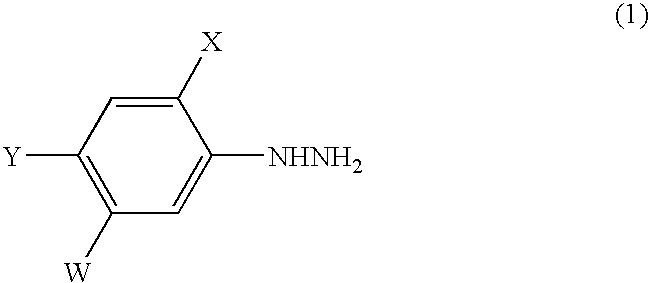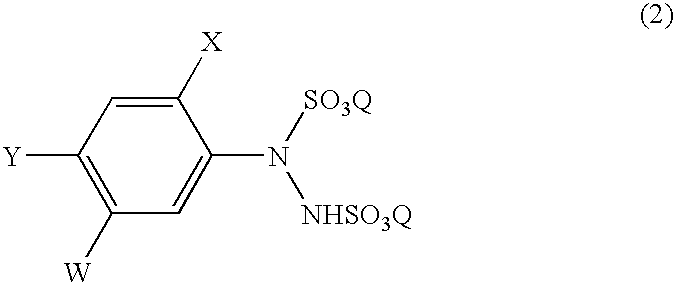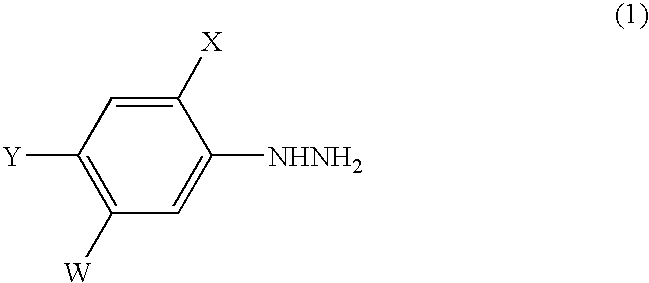Process for the preparation of phenylhydrazines
a technology of phenylhydrazine and inorganic acid salt, which is applied in the preparation of organic compounds, chemical apparatus and processes, and reaction mixtures, etc., can solve the problems of low filterability, reaction mixtures, and synthesis processes that may not be industrially preferred, and achieve the effect of efficient preparation
- Summary
- Abstract
- Description
- Claims
- Application Information
AI Technical Summary
Benefits of technology
Problems solved by technology
Method used
Image
Examples
example 1
4-Chloro-2-fluoro-5-hydroxyaniline (162.0 g; content: 99.6%, 0.999 mole) was added to 10% hydrochloric acid (1093.3 g) at 25° C. while stirring. Then, a 35% aqueous solution of sodium nitrite (205.9 g) was dropwise added to the mixture at a temperature of −3° C. to 0° C. over 1 hour to diazotize 4-chloro-2-fluoro-5-hydroxyaniline to obtain an aqueous solution of a corresponding diazonium salt (1456.7 g).
The diazonium salt was quickly added at 10° C. to an aqueous solution of sodium sulfite, which had been prepared by adding sodium sulfite (398.1 g) to water (1323.2 g) and then adjusting pH of the mixture at 7.2 with 95% sulfuric acid (15.1 g), and the mixture was heated up to 65° C., and maintained at the same temperature for 2 hours. Thus, the aqueous solution (3141.5 g) of sodium 4-chloro-2-fluoro-5-hydroxyphenylhydrazine-N,N′-disulfonate was obtained. According to LC-IS analysis, the yield of this sodium salt was 96.0% based on 4-chloro-2-fluoro-5-hydroxyaniline.
The obtained aque...
example 2-1
An aqueous solution (1314.1 g) of disodium 4-chloro-2-fluoro-5-hydroxyphenylhydrazine-N,N′-disulfonate was prepared in the same manner as in Example 1 using 10% hydrochloric acid (437.7 g), 4-chloro-2-fluoro-5-hydroxyaniline (65.0 g; content: 99.6 g; 0.401 mole), a 35% aqueous solution of sodium nitrite (83.1 g), water (539.6 g), sodium sulfite (159.5 g) and 95% sulfuric acid (12.7 g). The obtained aqueous solution was concentrated to 865.9 g by evaporating water at 56° C. under 107 mmHg over 4 hours.
example 2-2
Then, the concentrated aqueous solution (266.4 g) of disodium 4-chloro-2-fluoro-5-hydroxyphenylhydrazine-N,N′-disulfonate was dropwise added to 35% hydrochloric acid (223.5 g, 2.146 moles) over 2.5 hours while cooling hydrochloric acid at 10° C., and further reacted at the same temperature for 9 hours to obtain a reaction mixture (486.5 g) (81.2% of 4-chloro-2-fluoro-5-hydroxyphenylhydrazine; 2.7% of the dechlorinated compound (by-product); LC area percentages). After the filtration of the reaction mixture, the residue was dried to obtain a pale pink solid mixture containing 4-chloro-2-fluoro-5-hydroxyphenylhydrazine hydrochloride (61.9 g) (96.5% of 4-chloro-2-fluoro-5-hydroxyphenylhydrazine; 0.1% of the dechlorinated compound (by-product); LC area percentages).
According to LC-IS analysis, the yield of 4-chloro-2-fluoro-5-hydroxyphenylhydrazine was 89.4% based on 4-chloro-2-fluoro-5-hydroxyaniline.
The water contained in the reaction mixture was 311 g, and thus the amount of the inor...
PUM
| Property | Measurement | Unit |
|---|---|---|
| concentration | aaaaa | aaaaa |
| acid | aaaaa | aaaaa |
Abstract
Description
Claims
Application Information
 Login to View More
Login to View More - R&D
- Intellectual Property
- Life Sciences
- Materials
- Tech Scout
- Unparalleled Data Quality
- Higher Quality Content
- 60% Fewer Hallucinations
Browse by: Latest US Patents, China's latest patents, Technical Efficacy Thesaurus, Application Domain, Technology Topic, Popular Technical Reports.
© 2025 PatSnap. All rights reserved.Legal|Privacy policy|Modern Slavery Act Transparency Statement|Sitemap|About US| Contact US: help@patsnap.com



